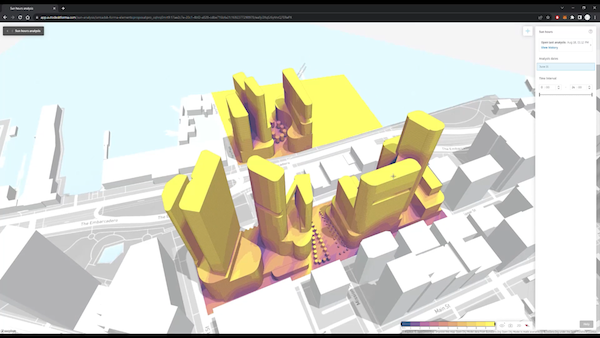
In the rapidly growing city of Nairobi, Kenya, affordable housing is difficult to find. The city’s population has more than doubled since 2000 and now exceeds 5 million. With many Kenyans moving to Nairobi for career opportunities, the growing demand for housing has far outpaced the supply of available housing.
An innovative AEC firm has recognized the housing crunch as a professional opportunity and is using its collective skills to help address the need for affordable, sustainable housing. Technology is playing a key part in the work, with the firm adopting BIM and other tools to maximize efficiency and get projects off the ground.
Nairobi-based BuildX Studio saw the already dire need for housing magnified by the pandemic, with people spending more time in their homes, and decided to take a more active role in addressing the problem. Firm leaders began asking questions, such as, “How can we improve urban housing in Nairobi?’” said Etta Madete Mukuba, architect and affordable housing lead at BuildX Studio. The firm has specifically sought to provide “more dignified, sustainable, livable housing,” she noted.
With the firm already offering a diverse suite of services, including architecture, engineering, and construction, BuildX Studio leaders decided to diversify even further and form a separate entity focused on housing development. Sister firm Zima Homes is now leading development of a pilot project of 137 homes near the Nairobi Western Bypass Highway, a new roadway designed to direct motorized traffic away from the Nairobi central business district.
Seeking Sustainability and Affordability
The Zima Homes development has been designed with healthy and sustainable features at the forefront, said Madete. Consisting of three blocks of buildings with a central courtyard, the complex offers open space between the buildings, providing efficient use of space and aesthetically pleasing views. Residents have access to an outdoor courtyard, recreation area, and an accessible rooftop.
Rendering of the Zima Homes complex shows the rooftop terrace, which includes plantings, seating areas, and common laundry areas. Image source: BuildX Studio. Click image to enlarge.
The buildings were designed to provide natural light and ventilation from openings on both sides of every unit. Fixed, sun-shading window screens help conserve energy. Kitchens and bathrooms are equipped with low-flow plumbing fixtures. The rooftop terrace includes seating areas and common laundry areas, with rainwater harvesting for laundry use.
Throughout the design, technology has been vital to success, according to Madete. Designed primarily with Autodesk Revit, along with a variety of other tools, the project required close collaboration across disciplines and multiple design iterations. She explained that using BIM “enabled us to ensure we’re getting the sustainability aspects right, such as sizing windows appropriately. It enabled us to get to sustainability and affordability in an efficient way.”
The need to balance sustainability and affordability presented challenges to the team. “It’s not easy, because sustainability has a cost,” said Madete. “The reality is [affordable housing] only makes sense at scale, 1,000 or more units. You need efficiency and standardization [to make projects economically viable],” she noted.
Madete, who is also a lecturer at the University of Nairobi in architecture, housing, and building technology, hopes that the pilot project will translate into larger projects, both for the BuildX/Zima Homes team and for other developers. “Affordable housing can be sustainable,” she said. “We want to provide the market with better options and ensure other developers don’t have any excuse [in not offering affordable and sustainable housing].”
Zima Homes has three blocks designed with a central courtyard of over 300 square meters of landscaped courtyard with recreation and seating areas. Image source: BuildX Studio. Click image to enlarge.
Putting Digital Tools to Work
In pursuit of efficiency on the Zima Homes project, the BuildX team transitioned from relying primarily on AutoCAD to using Revit as the main design tool. While the change presented challenges and required significant training, the benefits made the transition well worth the effort, according to Madete. “There’s a huge difference in workstream. For small projects, AutoCAD has its merits. It is more tactile and intuitive,” she said. For larger projects requiring coordination of multiple participants and design iterations, Revit provides more flexibility for modeling building designs and enabling collaboration, she noted.
Revit’s 3D capabilities and compatibility with other design tools have also proven valuable. Esther Segero, BuildX’s head of construction, said the 3D models produced by Revit have been helpful in visualizing the project. “In construction, a lot of the time we refer back to the 3D model in BIM 360. BIM makes for easy planning and easier to explain and work with teams that are remote.”
In addition to Revit and BIM 360, the BuildX team has used Autodesk’s Robot Structural Analysis Professional, Civil 3D, Insight Energy Analysis, Navisworks, ReCap Pro, and BIM Collaborate Pro. Compatibility of the tools has aided clash detection and resolution of other design issues. The firm’s work recently won a “Making a Better World” award at Autodesk University. The award cited the project as being “community built with locally sourced, alternative materials, and with 60% embodied carbon efficiency.”
Gil Heymann, Autodesk’s director of building design industry & business strategy, elaborated on the significance of the project. “BuildX Studio’s Zima Homes project is an exceptional example of what teams can achieve with innovative, sustainable design,” said Heymann. “This work perfectly captures the ambitions of the Autodesk Excellence Awards’ Making a Better World category, and we’re proud that Revit supported the creation of Zima Homes.”
Partners on the Zima Homes project are also enthused with the future opportunities created by the project. Ed Byron, Africa Project Management for Reall, a project investor, stated that “Zima Homes are focused on impact and being able to develop high-quality, climate-smart housing at an affordable rate that has impact for those who need it most.” Reall is financing approximately 60% of the project, with the developer funding the rest through sale of units.
Winnie Gitau, a co-founder of wall manufacturer Kwangu Kwako Limited stated: "This is the first time we are combining precast concrete panels with normal brick and mortar. We are happy to be part of technology that helps make affordable construction for people who are either renting or buying."
Kevin Sanya of property manager Fusion Capital noted that "there Is a big housing deficit in Kenya, that grows by 200,000 units every year, so we are happy to align ourselves with partners local and international who are focused on affordable housing."
Breaking Ground
The construction team broke ground on the project earlier this year, with completion slated for early 2024. BuildX’s Segero said field changes have been minimal so far, crediting early collaboration and use of 3D models to visualize the project. She acknowledged that other field issues are inevitable on a project of this size and complexity. “Although all the work was done on BIM, you should always anticipate that there will be some level of coordination issues.” When issues do occur, “the plan is to always have them updated in Revit,” she noted.
Construction of Zima Homes is underway and anticipated to be completed in early 2024. Image source: BuildX Studio. Click image to enlarge.
As construction progresses, BuildX is eyeing other opportunities to apply their experience on larger housing developments. Madete said the team seeks to expand standardization efforts and automate some of their processes with software in the future. “We need to scale up to larger projects to get a repeatable model that can also be site-specific,” she said.
Based on progress so far, the team appears well on their way to addressing a critical need for affordable housing in Nairobi.
Andrew G. Roe
Cadalyst contributing editor Andrew G. Roe is a registered civil engineer and president of AGR Associates. He is author of Using Visual Basic with AutoCAD, published by Autodesk Press. He can be reached at editors@cadalyst.com.
View All Articles








Share This Post